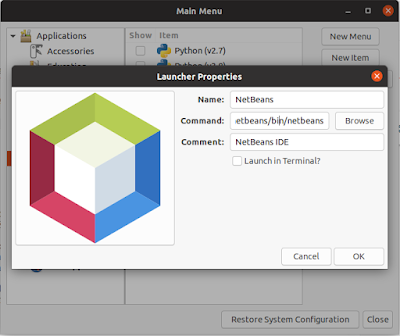This tutorial will explain how you can install Netbeans, the one of the most popular free software Java IDEs, completely with GUI designer. The graphical user interface (GUI) designer, also called rapid application development (RAD) tool, is a visual way to create applications by drag and drop alongside with writing lines of code. Now let's do it.
(Netbeans running on Ubuntu 20.04)
Subscribe to UbuntuBuzz Telegram Channel to get article updates.
About This Tutorial
Requirements
We will do this setup with the following requirements:
- Ubuntu 20.04 or later
- OpenJDK 11
- JRE 11
- Eclipse 2021-12
- Netbeans 12.6
- Eclipse's WindowBuilder 1.9.8
Pre-installation
Before installing Netbeans, we are required to have a Java Development Kit (JDK) installed first on our system. For that purpose, we install OpenJDK, the most popular jdk version and it is free software licensed:
$ sudo apt-get install default-jdk default-jre alacarte
Install Netbeans
1. Visit Download page at netbeans.apache.org.
2. At the Download page, click latest Netbeans for GNU/Linux version e.g. netbeans-15-bin.zip at the moment.
3. Extract the zip file in your Downloads folder.
4. You will have a new folder at the address /home/master/Downloads/netbeans.
5. Run Alacarte Menu Editor > create New Item under Programming category in the Menu Editor > fill the blanks as the following:
- Name: NetBeans
- Command: /home/master/Downloads/netbeans/bin/netbeans
- Comment: NetBeans IDE
(Menu Editor while adding a new item Netbeans to start menu)
8. Change the logo with NetBeans logo available under /home/master/Downloads/netbeans/nb/netbeans.icns. The icns is a picture file format.
10. Save and close the Menu Editor.
11. NetBeans installed.
Note: change the names 'master' in every address path above with your actual username.
Run Netbeans
Open Activities Menu > find Netbeans > run Netbeans > Netbeans runs.
Run Netbeans GUI Designer
1. Run Netbeans.
2. Create a new project.
3. Select Java with Ant under categories. Go next.
4. Select Java Application. Go next.
5. Name your project. Go next.
6. A new project created with a class source code file JavaApplication.java.
7. Right-click javaapplication package under Source Packages under JavaApplication project.
8. Select New > JFrame Form ... > Next > OK.
9. A new GUI designer will open with a frame and multiple toolkit items (buttons, panels, menus etc.) you can drag and drop.
10. Continue your development.
(NetBeans with GUI builder opened)
Preview Design
At any time, you can quickly show the preview of your GUI design:
1. Open the GUI designer.
2. Click eye button ("Preview Design").
3. A GUI window will show according to your design.
Alternative Installation Method by Snapcraft
If you for some reason cannot install Netbeans with aforementioned method, you can install it with Snap method (built-in Ubuntu) below:
1. Run Terminal.
2. Invoke command line below:
$ sudo snap install netbeans --classic
3. Enter your password.
4. Run Netbeans by command line:
$ snap run netbeans
5. Go to GUI designer the same way as aforementioned methods.
Notes
I live at Jawa Timur, Indonesia. Jawa Timur (East Java) is the eastern province of Java Island, the real and origin of Java name. Of course, I write this while drinking a Javanese coffee. Thank you and happy hacking!
This article is licensed under CC BY-SA 3.0.








